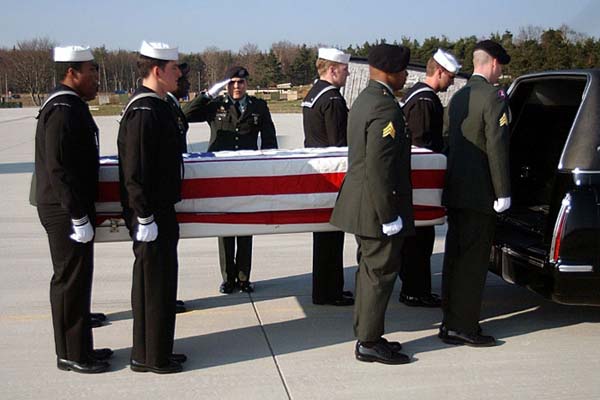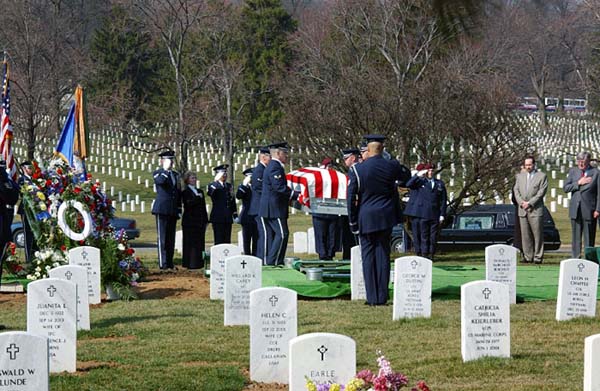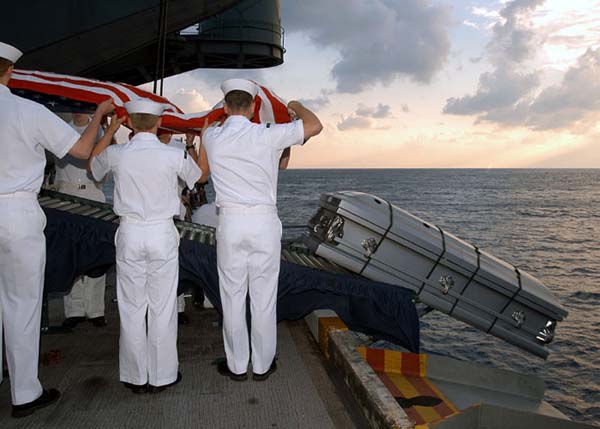Return of the Fallen
- Page 2
To Cover Up Our Losses The Media Was Forbidden
To Show Flag Draped Coffins. A Lawsuit Released The Images.

RETURN OF THE FALLEN
Thomas Blanton, Director of the National Security Archive, which actively uses the Freedom of Information Act to force release of government documents, said, "The government now admits it was wrong to keep these images secret. Hiding the cost of war doesn't make that cost any less. Banning the photos keeps flag-draped coffins off the evening news, but it fundamentally disrespects those who have made the ultimate sacrifice."
Blanton and Begleiter noted one major negative consequence of the dispute over the images: the Pentagon appears to have stopped creating the photos in the first place. All the released images containing date information appear to have been taken prior to June 2004. Military officials told Begleiter and the news media that such photos were no longer being taken since his first Freedom of Information Act request was filed in April 2004.

RETURN OF THE FALLEN
Begleiter said, "Hiding these images from the public - or, worse, failing even to record these respectful moments - deprives all Americans of the opportunity to recognize their contribution to our democracy, and hinders policymakers and historians in the future from making informed judgments about public opinion and war." He called on the Pentagon to resume fully documenting the return of American casualties.
Although some of the newly released images include dates, locations and other information, the Pentagon censored that information from most of the released images. Some of the censorship, or, as the Pentagon prefers to call it, "redaction," blacks out faces, identifying features on equipment, and uniform styles. In one case, for example, a clergyman's identity is censored, while in another image, a different clergyman remains unredacted.
"I cannot imagine that the members of these honor guards want their own faces blacked out from the public homage that is due," Blanton said. "Honor guard is the most solemn duty for anybody in the military, not something for the censors to hide."

RETURN OF THE FALLEN
The photos released by the Pentagon were taken by U.S. government photographers, not by journalists. "There is nothing macabre or ghoulish about these images," said Begleiter. "These are among the most respectful images created of American casualties of war - far less wrenching than images we regularly see from the battlefield. They're taken under carefully controlled circumstances by military photographers covering honor ceremonies."
An initial release of 361 such images was provided by the
Pentagon in April, 2004 in response to a Freedom of Information Act appeal
by Russ Kick, who maintains the web site thememoryhole.org. The Pentagon
later declared that release to have been a mistake and refused to release
further images, which prompted Begleiter and the National Security Archive
to challenge the policy.
The Freedom of Information Act case was filed in Federal District Court
for the District of Columbia [Case No. 1:04-cv-01697 (EGS)].
The newly released images, along with many other details of the Freedom of Information Act case, may be seen at: www.nsarchive.org.

RETURN OF THE FALLEN
SOURCE OF ALL PHOTOS; NATIONAL SECURITY ARCHIVE
Historical note:
The ban on media coverage of returning casualties was imposed by Defense
Secretary Cheney after an embarrassing incident in which three television
networks broadcast live, split-screen images in December, 1989, as the
first U.S. casualties were returning from an American assault on Panama.
In that incident, President Bush was seen on television joking at a White
House news conference while somber images of flag-draped coffins arriving
at Dover Air Force Base moved across viewers' screens. The ban on war
casualty images was continued during the Clinton administration, which
made several exceptions to allow publication and broadcast upon the return
of victims of attacks against U.S. personnel abroad, including the bombing
of the U.S.S. Cole in 2000. President George W. Bush continued the ban
following the start of the Afghanistan war in October, 2001 and the Iraq
invasion in March, 2003.
THESE MATERIALS ARE REPRODUCED FROM WWW.NSARCHIVES.ORG WITH THE PERMISSION
OF THE NATIONAL SECURITY ARCHIVE.